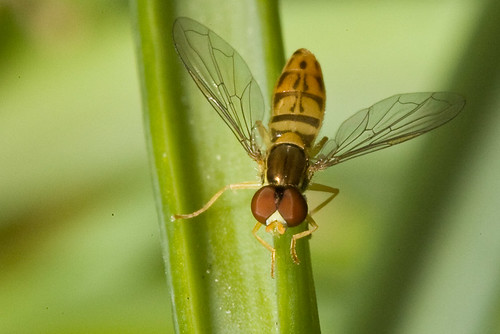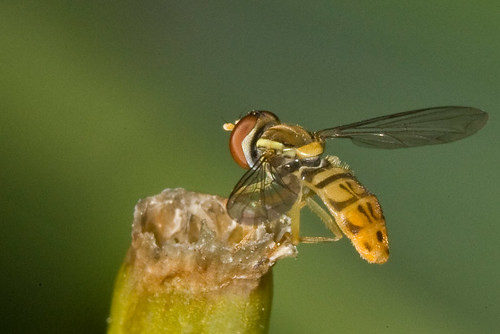Hover fly
We've had a couple posts about other pollinators and some of the problems facing them. Here then is a brief (real brief) look at another cosmopolitan invert pollinator—the hover fly.
Before we go any further yes, it does look a lot like a bee or wasp. The hover flies are masters of Batesian mimicry (think sheep in wolves clothing). There are many species of hover fly which mimic bees, hornets, and wasps. At a casual glance of the painted blanket flowers in our garden it often looks like there are three species of bees when most often it is a hover fly joining a European honey bee and a bumble bee. The hover fly is even reported to mimic the stinging action of a bee pressing the tip of it's abdomen towards a restraining hand.
Hover flies are true flies (Diptera) of the family Syrphidae with 6000+ species. Like all true flies, they have one pair of wings, whereas the bees and wasps (and all order Hymenoptera) have two pairs of wings even though they are usually seen as one pair because the hindwing is linked to the forewing by a velcro like structure. In place of the second wings the hover flies have haltares which act a bit like gyroscopes to help the flies balance. The flies have very large eyes, and short antennae unlike bees and wasps. Some hoverflies wave their front legs in front of the heads to mimic the longer antennae. The hover flies are prolific breeders with some species going from egg to adult in as few as two weeks during the summer.
All those generation can be a boon to gardeners and agriculture. The larvae (maggots) of many species are voratious predators of aphids, thrips, leafhoppers and other soft bodied insects. Other hoverfly species larvae however can be pests including bulb and stem eating maggots. More species can be found in stagnant water or eating decaing plant material. There is in fact huge diversity of feeding among the larvae. Almost all adults however feed on pollen and nectar. They are importnat polinators of many flowering plants including such important commercial crops as carrots, onions and many species of fruit tree.
- Kingdom
- Animalia
- Phylum
- Arthropoda
- Subphylum
- Hexapoda
- Class
- Insecta
- Order
- Diptera
- Family
- Syrphidae






















I sometimes laugh when I see these guys. They hover around me and I just shoo them thinking, "you're not a wasp."
ReplyDeleteAlex